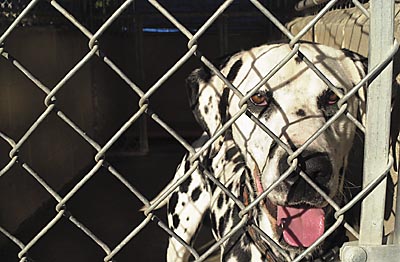The Hollister Animal Shelter handled far more animals in 2002
than any year since opening in 1982.
”
It’s doubled (the number of animals) since the shelter
opened,
”
said Julie Carreiro, animal control supervisor at the
shelter.
Data on animal control and other information such as shelter
revenue is included in the Hollister Animal Control Division’s
annual report. The City Council adopted the document at Monday
night’s meeting.
The Hollister Animal Shelter handled far more animals in 2002 than any year since opening in 1982.
“It’s doubled (the number of animals) since the shelter opened,” said Julie Carreiro, animal control supervisor at the shelter.
Data on animal control and other information such as shelter revenue is included in the Hollister Animal Control Division’s annual report. The City Council adopted the document at Monday night’s meeting.
In 2002, Animal Control, which is funded by the city, housed 4,053 animals – a sharp increase from the 2,899 in 2001.
“The bottom line of dogs and cats has gone up a couple hundred animals each year,” Carreiro said.
Aside from the city’s growing human population, Carreiro said several cases of animal cruelty caused the large increase of animals in recent years.
“In 2002, we had several very large cruelty cases involving roosters, guinea pigs and dogs,” she said.
The most notable recent cruelty case occurred in April 2001 when animal control officers seized 130 dogs and puppies from Kenneth Hershey in San Juan Bautista. Hershey held the animals as part of an illegal breeding operation.
Since 1994, the number of animals housed at the shelter has more than doubled, according to the report. That increased flux of animals has caused several problems, Carreiro said.
“It causes an increased disease rate,” she said. “The cost to house (the animals) goes up. Not to mention how many staff are needed to take care of animals.”
In a study released in August 2002, the San Benito County Grand Jury claimed the shelter was in “emergency need for a larger building.” At that time, Carreiro said shelter officials had tried to convince the city to upgrade the facility for the past five years.
She said animal shelter staff in 2002 was forced to euthanize so many cats – 950, compared to 820 last year – because the shelter “just plain ran out of space.”
On the other hand, an increase in adoptions has helped offset the animal glut, Carreiro said. Since 1994, adoptions have increased almost three-fold.
Also glaring among the data included in the annual report was shelter revenue, which primarily comes from dog licensing fees. That income jumped to $77,888 – up from $41,620 in 2001.
Clay Lee, director of management services and the city’s overseer of shelter operations, attributed the increase to a more aggressive program in seeking the annual license fees. All county residents who own a dog are obligated to pay.
Pet owners can purchase a license for one to three years. If the dog is spayed or neutered, the cost for one year is $9. If not, the cost for one year is $18.
“We were not generating the revenue that we should have,” Lee said.
He attributed the improvement to better technology and a more efficient tracking system. The computer advancement significantly helped, he said, because the shelter only employs three workers at a time.
“It’s the collection process, the technology,” Lee said. “It’s amazing when you have a computer that can spit all that stuff out.
“We have a much more efficient system,” he said.
The annual report categorized total animals, total adoptions, road kill, revenue, animals returned to owners, animals euthanized, total deaths and total calls.
Lee said the shelter mostly housed dogs and cats – 1,303 and 1,608, respectively – in 2002. But he said an array of other animals also stream in from time to time. In 2002, the shelter took more than 1,000 “other animals.”
The shelter, which is open from Monday through Saturday, is located on the west end of South Street. For more information, call Carreiro at 636-4320.










